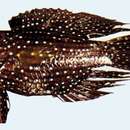Diagnostic Description
provided by Fishbase
Characterized by having tubed lateral-line scales 19-20+9-10; depth of body 2.5-2.7 in SL; dorsal and anal fins elevated posteriorly; rounded caudal fin. The false eye which is actually the dorsal fin ocellus confuses predators because it poses an inverted image of a fish. When alarmed, this fish will poke its head into a hole and expose its tail end which mimics the head of the moray eel (Ref. 9710). Head and body brownish black with small pale blue spots; vertical and pelvic fins dark orange-brown, with many small blue spots; blue ringed black ocellus above base of last 3 dorsal rays; yellow spots at base of upper caudal rays; pectoral rays bright yellow, fin membrane transparent (Ref. 10430).
- Recorder
- Cristina V. Garilao
Life Cycle
provided by Fishbase
Eggs are guarded by the male parent (Ref. 205).
Morphology
provided by Fishbase
Dorsal spines (total): 11; Dorsal soft rays (total): 8 - 10; Analspines: 3; Analsoft rays: 9
- Recorder
- Cristina V. Garilao
Trophic Strategy
provided by Fishbase
Inhabits coral reefs (Ref. 58534); adults found near in caves and crevices along drop-offs (Ref. 8631). A nocturnal species that hides under ledges and in holes by day (Ref. 9710).
- Recorder
- Drina Sta. Iglesia
Biology
provided by Fishbase
Adults are found near reefs, and in caves and crevices along drop-offs (Ref. 8631). A nocturnal species that hides under ledges and in holes by day (Ref. 9710). They possess a false eye which is actually the dorsal fin ocellus confuses predators because it poses an inverted image of a fish. When alarmed, this fish will poke it's head into a hole and expose its tail end which mimics the head of the moray eel (Ref. 9710). Eggs are guarded by the male parent (Ref. 205). Have been reared in captivity (Ref. 35426). Reported to be living in a marine aquarium for 8 years and 6 months (Danilo Ronchi, Italy, pers.comm. 2014 February).
Importance
provided by Fishbase
aquarium: public aquariums

